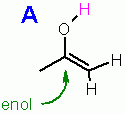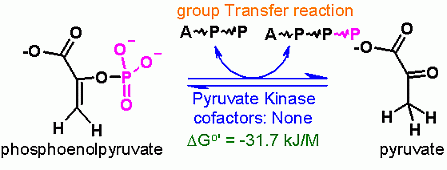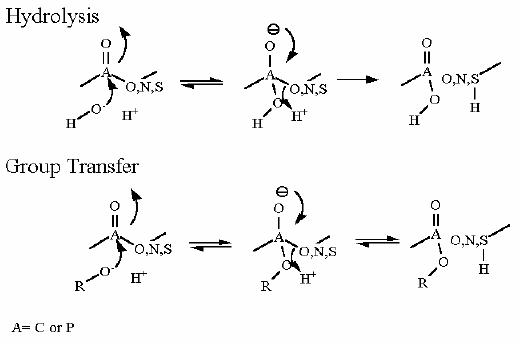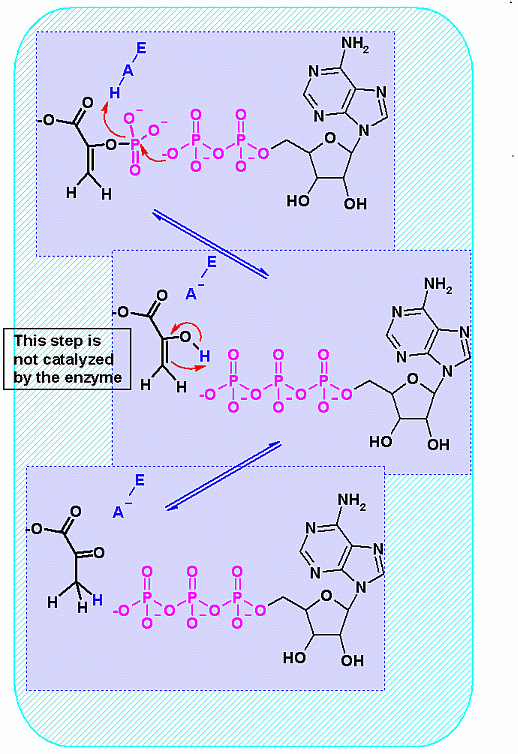|
The Enol functional group.
Just prior to this enzyme in the pathway an elimination reaction (hydroxyl -OH group from C3 and a hydrogen from C2) generated a carbon-corbon double bond between C2 and C3. Compounds that contain a carbon - carbon double bond (C=C) are always named with an ending of -ene. For example Propane is a three carbon compound with only single bonds between carbons and all other bonds are filled by hydrogen. Propene is the same except that it contains one C=C. In the case of phosphoenolpyruvate, C2 has this double bond to C3 AND it also has a hydroxy group on C2 on it as well. Therefore C2 is now named an "enol" ("en" = ene for the C=C and "ol" is for alcohol).
The significance of the Enol group
 Enols are not very stable in water. Generally there is a rapid, facile, nonezymatic conversion between an enol and a ketone. This type of conversion is called tautomerization and can occur extremely quickly. Thermodynamically, the ketone form is greatly favored - therefore the ketone is in much high concentration than the enol fom. Enols are not very stable in water. Generally there is a rapid, facile, nonezymatic conversion between an enol and a ketone. This type of conversion is called tautomerization and can occur extremely quickly. Thermodynamically, the ketone form is greatly favored - therefore the ketone is in much high concentration than the enol fom.
There is one caveat... The conversion is allowed to occur only IF the the enol has an -OH on it like compound "A" ... because the terminal -H must be able to dissociate as H+ for the conversion. because the terminal -H must be able to dissociate as H+ for the conversion.
In phosphoENOLpyruvate, the enol does not terminate with -H but with -PO3 like compound "B" which cannot dissociate therefore the molecule is trapped in the less favorable enol form. which cannot dissociate therefore the molecule is trapped in the less favorable enol form.
Thermodynamically speaking hydrolysis of phosphate from phosphoenolpyruvate has a very high favorable Standard Free Energy because two things happen... we get the hydrolysis AND then the enol converts mostly to the much more favorable ketone.
How much energy is in the Ketone / enol conversion. The ΔGo' as written is +45 kJ/M which means that the ketone form is favored by a factor of ~65,000,000 over that of the enol form in pyruvate.
The extra energy from this can be used to transfer the phosphate from PEP to ADP to make ATP.
|


 Enols are not very stable in water. Generally there is a rapid, facile, nonezymatic conversion between an enol and a ketone. This type of conversion is called tautomerization and can occur extremely quickly. Thermodynamically, the ketone form is greatly favored - therefore the ketone is in much high concentration than the enol fom.
Enols are not very stable in water. Generally there is a rapid, facile, nonezymatic conversion between an enol and a ketone. This type of conversion is called tautomerization and can occur extremely quickly. Thermodynamically, the ketone form is greatly favored - therefore the ketone is in much high concentration than the enol fom. because the terminal -H must be able to dissociate as H+ for the conversion.
because the terminal -H must be able to dissociate as H+ for the conversion. which cannot dissociate therefore the molecule is trapped in the less favorable enol form.
which cannot dissociate therefore the molecule is trapped in the less favorable enol form.




